1lumen selects and reviews products personally. We may earn affiliate commissions through our links, which help support our testing.
Nightwatch NS59v1 review
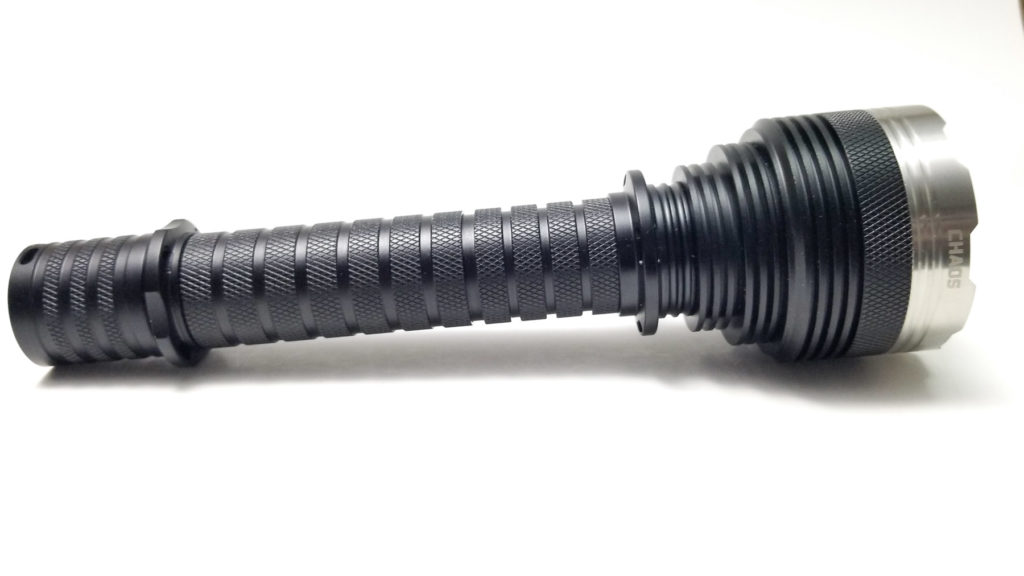
Nightwatch NS59v1 specifications
| Brand/model | Nightwatch NS59v1 |
|---|---|
| LED | 9*SFQ55 |
| Max. Lumens | 28,000 lm |
| Max. Beam intensity / distance | N/A |
| Battery config. | 2*21700 |
| Onboard charging | N/A |
| Modes | 5 |
| Blinkies | None |
| Reflector | OP |
| Waterproof | IPX2 |
| Review date | May 2022 |
Introduction:
Every once in a while a flashlight comes along that redefines the term ‘crazy.’ A few come to mind in the last several years: The Astrolux MF05, Lumintop GT94, Imalent MS18, Maxtoch Owleyes, and the Acebeam W50 (which we can’t buy) to name a few. If you’re looking for the throwiest and brightest flashlights in the world, any one of those would suffice. Trouble is they’re as expensive as they are crazy. This is where I introduce you all to Neal Zhang of Nealsgadgets. Thanks to Neal, enthusiasts have been able to sample the more affordable crazy bright flashlights coming out of China. Nightwatch is one particular brand.
Usually sold exclusively on the Chinese language retailer Taobao, they’re no stranger to 1Lumen. Owen tested the bonkers NSX4 a while back, and I tested the NI03 Valkyrie not too long ago. Both of those lights delivered many thousands of Lumens for well under $100. Nealsgadgets started selling a new Nightwatch, and if it performs as promised, will definitely raise the price to performance bar a bit higher. How high? How’s 28,000 (advertised) Lumens for about $100 sound? Here’s the tale of the tape: 9 high performance quad die LEDs, FET driver, and two 21700 in series (trust me, it needs two). Interested? Me too, and I’ve got my hands on one to test! Huge shout out to Neal for sending the brand new Nightwatch NS59v1, AKA Chaos, for review. Let’s see how chaotic it is. I imagine the runtimes will be.
Package quality.
One area Nightwatch doesn’t invest heavily in is packaging, and for enthusiasts, it’s no biggie. The NS59v1 came in a very plain (and very mutilated) white box. The light was wrapped in bubble wrap with no accessories and miraculously, the light was undamaged. I wasn’t expecting anything else, but surprise! Two of Neal’s special 21700s (which are optional add-ons) were hiding in the tube. Instead of a plastic isolator disc to keep the cells from discharging during storage, someone tore off a piece of packaging and stuck it under the tailcap contact. Nice.
- Nightwatch NS59v1
- Two 21700 batteries (loaded in the light)
This is an enthusiast light to the core (not for the faint of heart), so accessories are inconsequential. No manual either (which enthusiast light needs a manual anyway?), but again, if you’re buying this light, you probably know what to do and what not to do with it.
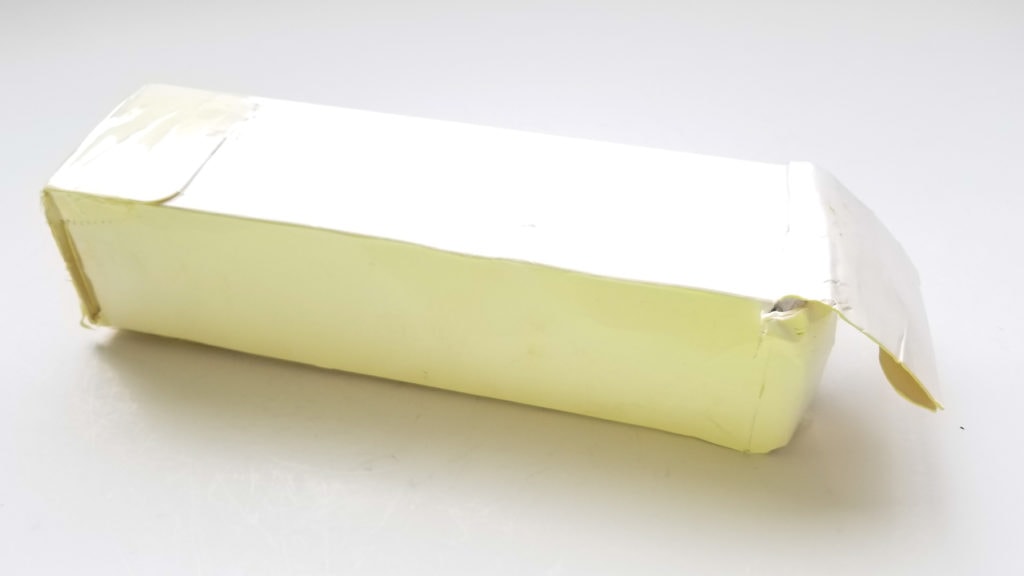
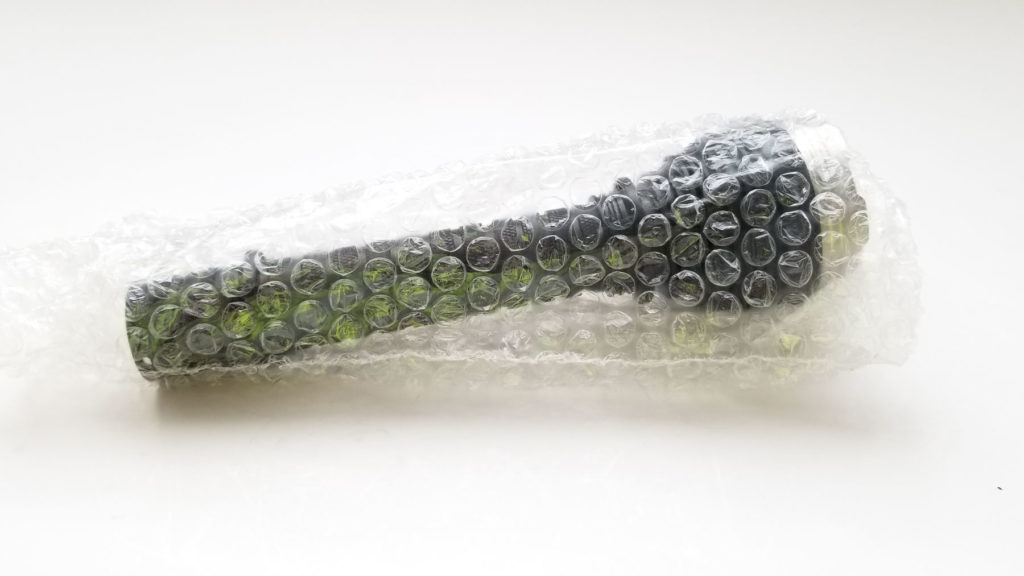
Flashlight in use
Let’s define the use case in context with the Nightwatch NS59v1. This is a portable, handheld illumination tool and can be used to light stuff up…like a football field or a large warehouse for instance. It’s bright enough to scare off the boogie man or Sasquatch, but can also be used when walking your pomeranian or labradoodle. In all seriousness though, this does what a flashlight does best, just on a grander scale. Handling-wise, the light is long and slender, and handles a bit like my Wurkkos DL70.
I’m used to the soda or soup can form factors for lights like these, so I’m really liking the compactness and slim form factor of this light. The tube houses two 21700 size batteries arranged lengthwise in series with a single mechanical reverse clicky switch on the tail. I didn’t realize it at first, but the battery tube is two pieces, and it unscrews about halfway in the middle. I’m not sure why? Maybe this light was offered as a single-cell version in China? The tube is reversible, and you can screw the shorter end into the head to get a single 21700 size NS59v1, but it doesn’t work with a single cell. It looks cool though, and makes it super handy.
The battery tube, a thin strip on the head, and the tailcap have diamond pattern knurling, and although it’s not as grippy as some other knurling I’ve felt, it still allowed for a nice purchase on the light. The rear switch works fine. It didn’t feel as good as some other clickies. Although it has good feedback, the clicks weren’t as snappy and it felt a bit soft. The switch didn’t require much effort to engage either, and that could be an issue on a light with this much firepower. For alternate grip or retention options, the tailcap has a dual lanyard hole, and there’s a removable aluminum tactical grip ring held on by friction provided by two o-rings and it has 4 points for mounting a lanyard. A nice feature here is there’s another removable ring at the front of the tube. It’s a bit larger and also has 4 slots for threading a lanyard or a sling for over the shoulder carry. I did find using it in a tactical cigar grip a bit awkward, but overall, despite being quite front-heavy, the NS59v1 handled well and was nicely balanced in either the overhand or underhand grip and, it’s much handier than a soda can design.
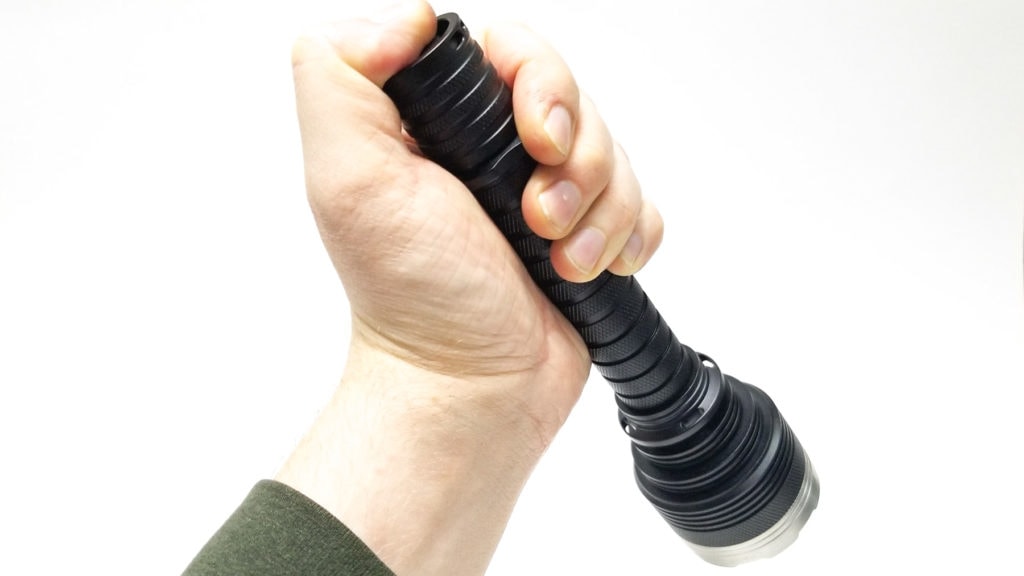
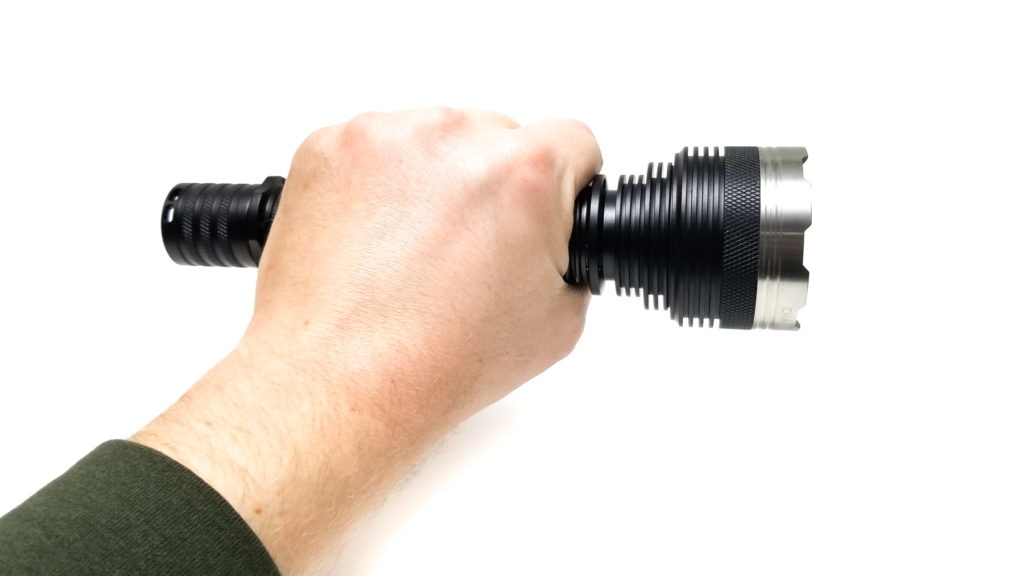
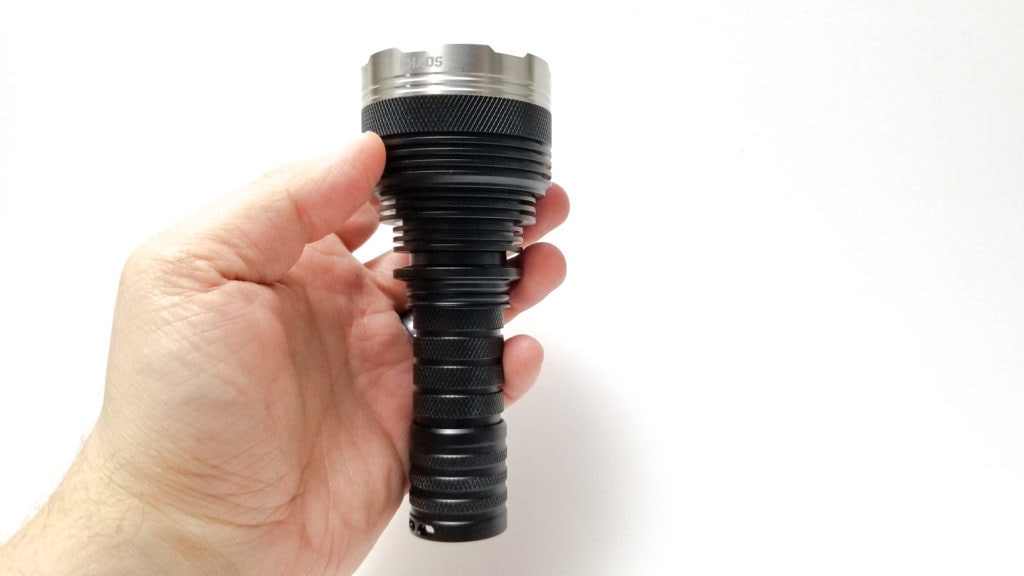
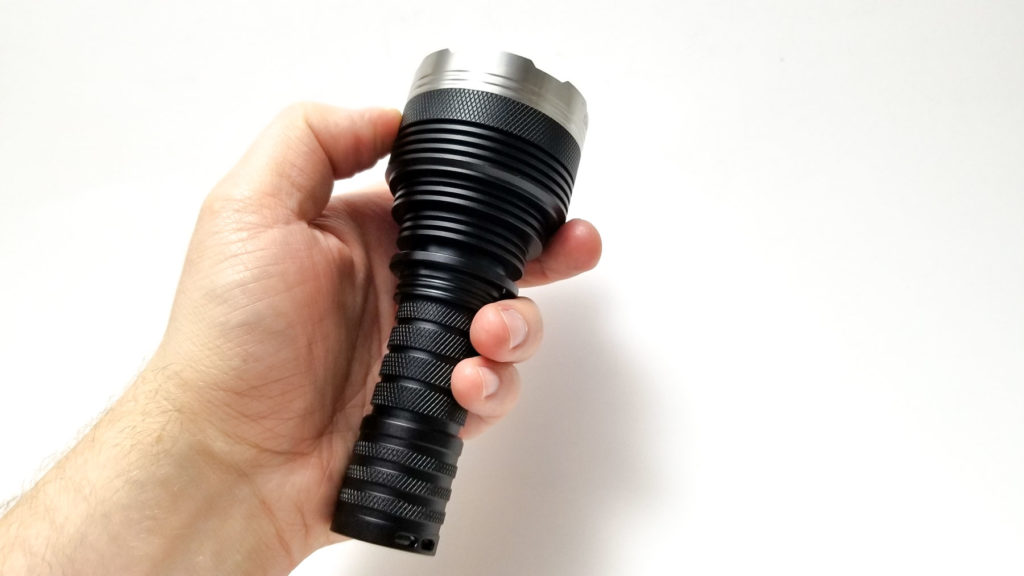
Build Quality, and Warranty
Although the Chaos isn’t Acebeam or Fenix-level quality, fit, and finish, for the price I’m not complaining one iota since if you look at price vs. performance, the NS59v1 is a fantastic value. Depending on how you option it (with or without batteries, plain, or stainless bezel) the NS59v1 sells for $90 up to $116+, I do recommend getting the battery bundle if you don’t have a matched pair of high drain button top 21700s.
The light is milled from aluminum, and the machining is perfectly adequate and free of major defects and blemishes. There’s a good amount of heat sinking fins on the head and they were precisely machined. The parts fit together nice and flush, and I didn’t notice any quality control issues. The stainless bezel is nothing to write home about and there were some obvious tool marks, abrupt edges, and small chips on the edges. Nothing major though and I’d say still acceptable at this price point. The finish is advertised as type III HA hard anodizing, and it’s a semi-gloss black and seems to be about the same glossiness as some Fenix lights I have. It’s nicely applied and even with no thin or bare areas that I could see.
Look Ma, no glue! The Chaos breaks down easily. The bezel unscrewed by hand along with the head and battery tube. The tail switch and driver are held in by brass retaining rings that can be removed with snap ring pliers. I was able to disassemble the tailcap easily, but it seems the driver is glued in or the LED wires are very short. There’s no spring for the driver, just a thick brass slug, and the tailcap has a seemingly too-thin coil spring that’s bypassed by a 4.5 mm wide strip of metal contacting the negative side of the battery. This is necessary to handle the massive current load that would otherwise melt that puny spring. The switch is a genuine Omten PBS101, good for AC 125 V and 1.5A, so it should be okay for short applications of Turbo. It’s a decent switch, but in this application it’s touchy…clicking into Turbo is a bit tricky and requires timing it just right.
The battery tube threads front and rear are rectangular cut and sturdy. They weren’t anodized, so lockout isn’t possible, and were positively swimming in what seemed like the copper-color anti-seize lubricant used on exhaust manifold bolts rather than the silicone lube I’m used to. This made the threads super smooth, although I’ll probably clean it off and add some SuperLube synthetic grease later. The light is sealed up very nicely with dual o-rings at the front and rear of the battery tube, dual o-rings sealing the joint between the two tube halves, a single o-ring sealing the bezel and a large silicone one sealing the lens. No IP rating is specified, but with no charge port to seal and all those o-rings, I’d imagine heavy rain or a temporary dunking wouldn’t be an issue.
Warranty? I didn’t see any implied, but Neal is good about defective products or issues and will happily send replacement parts if needed.
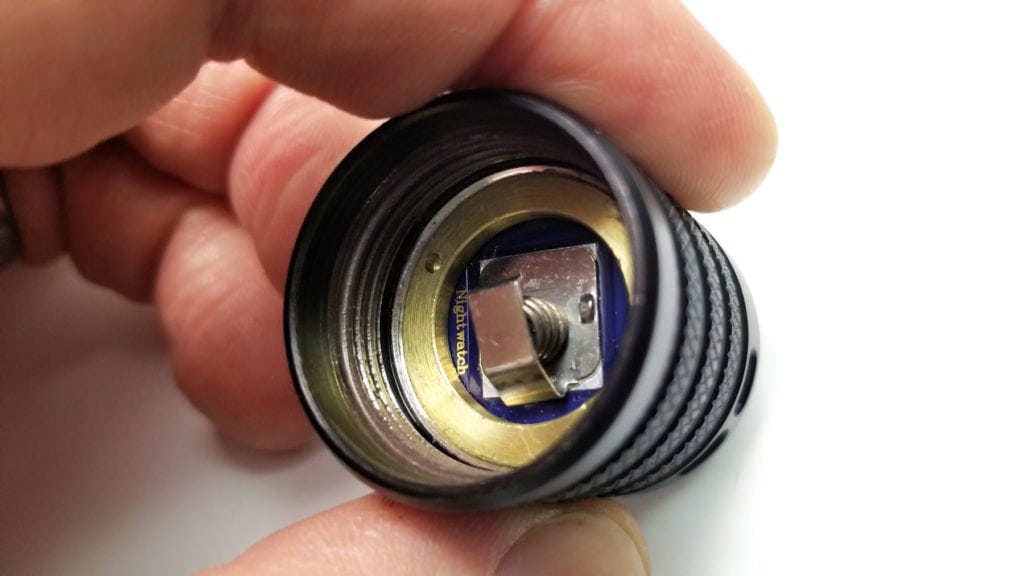
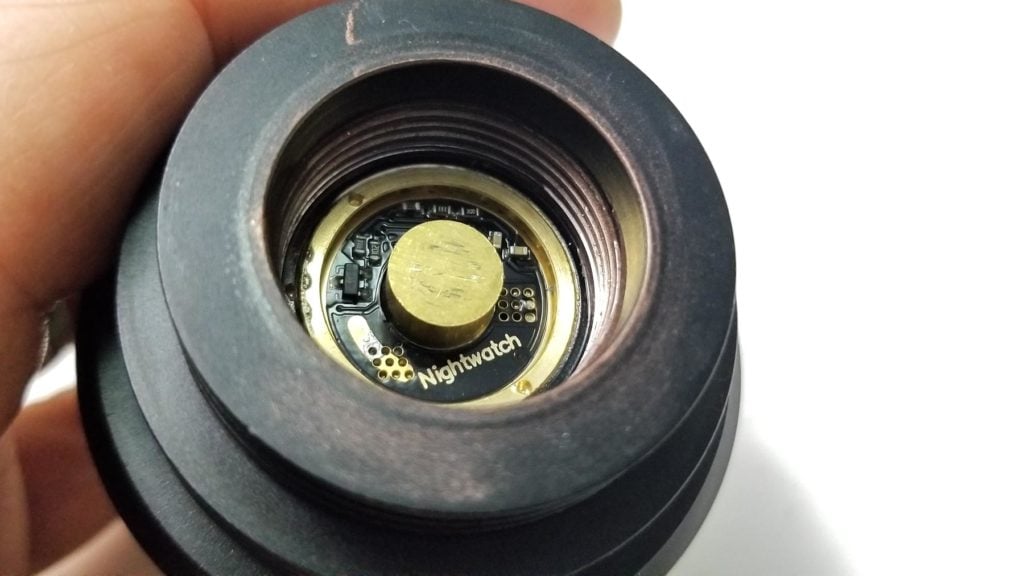
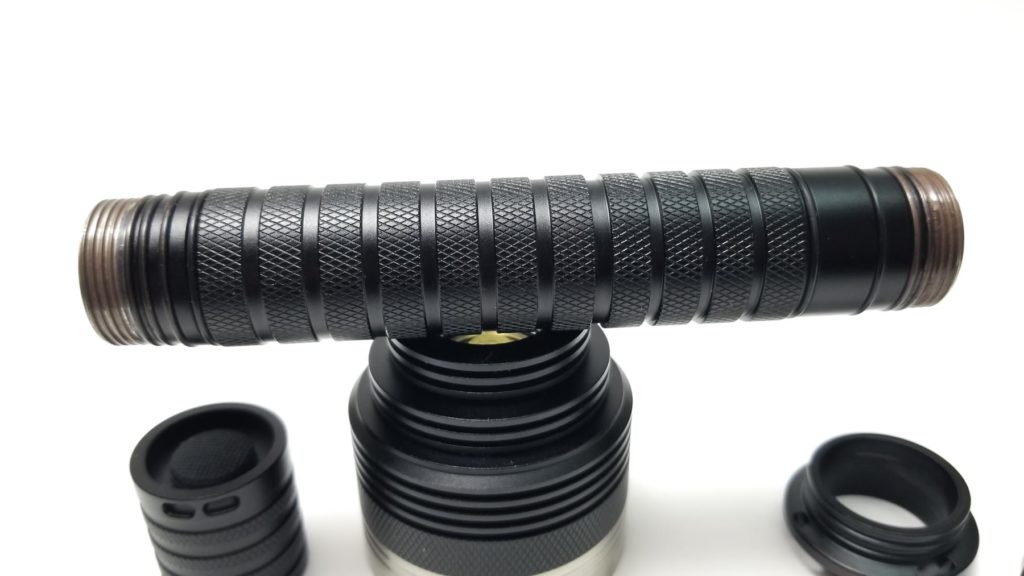
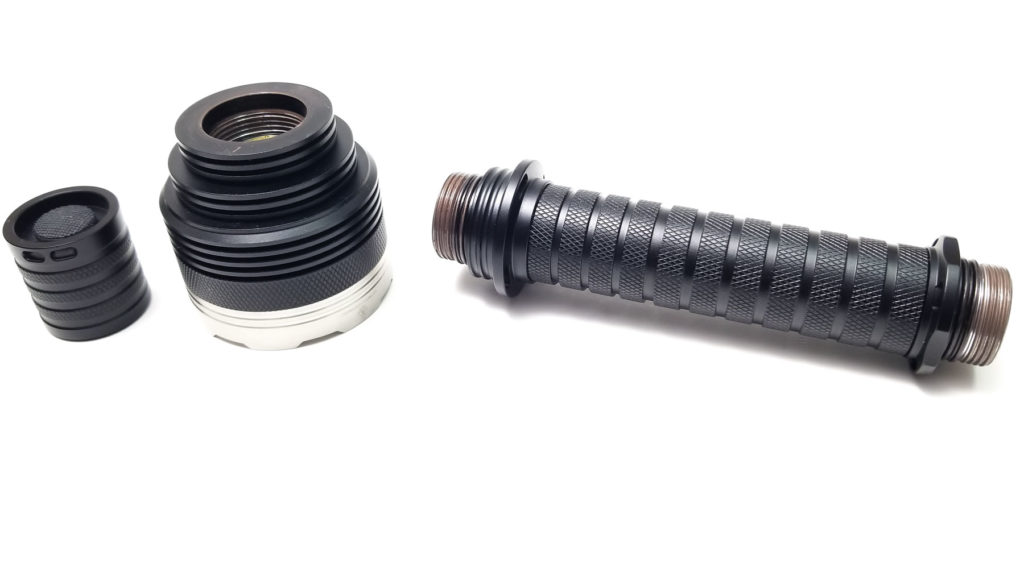
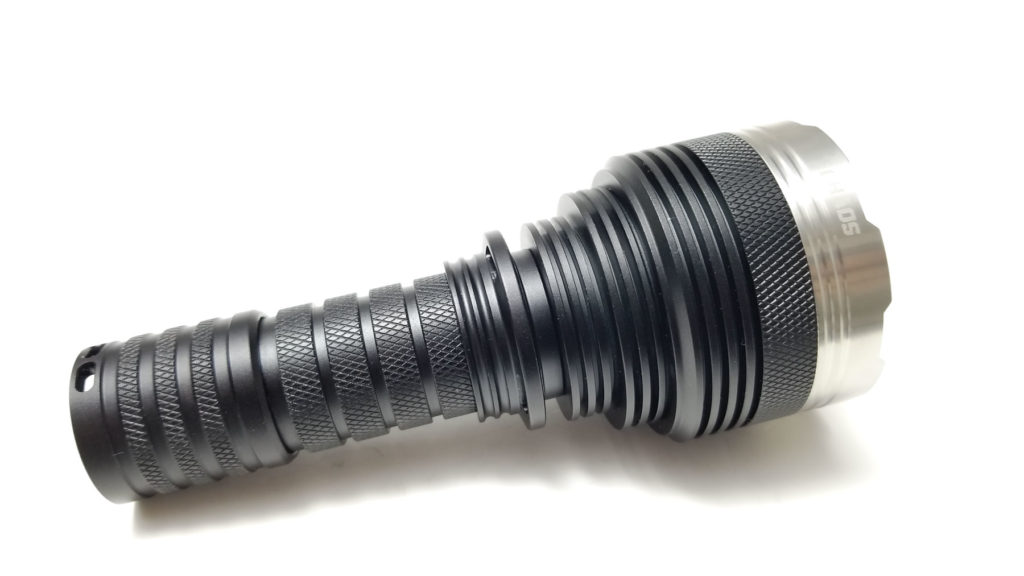

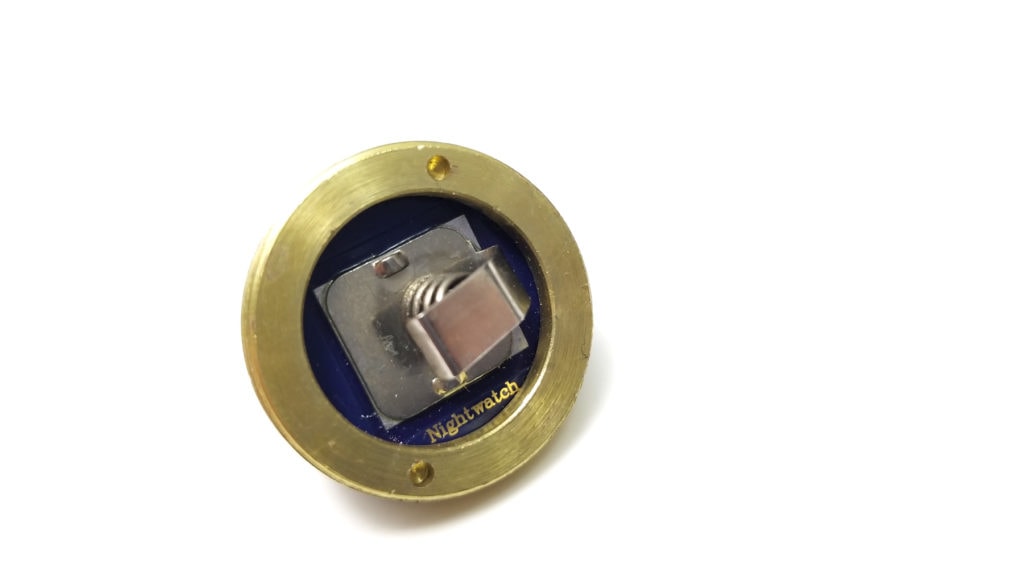
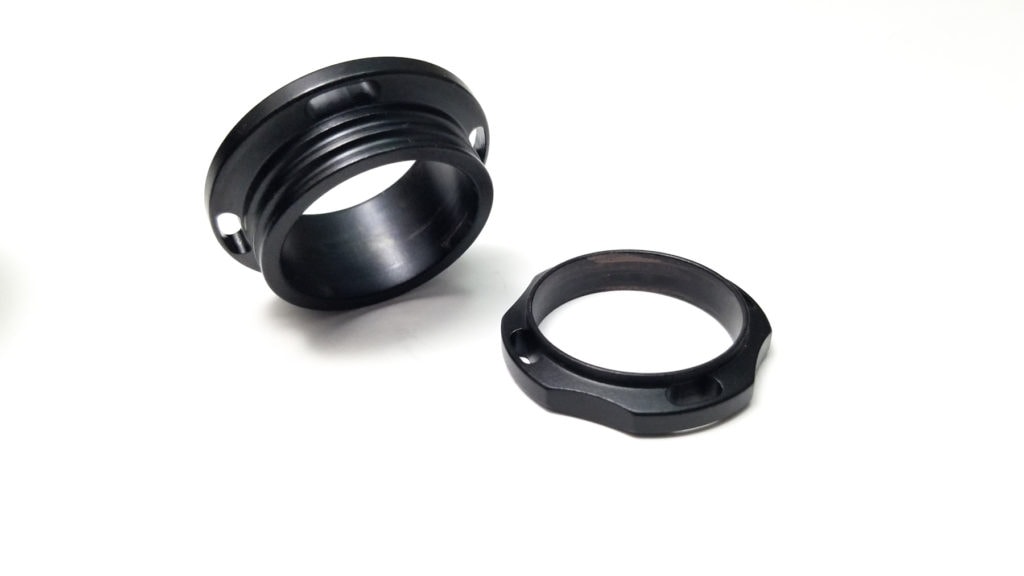
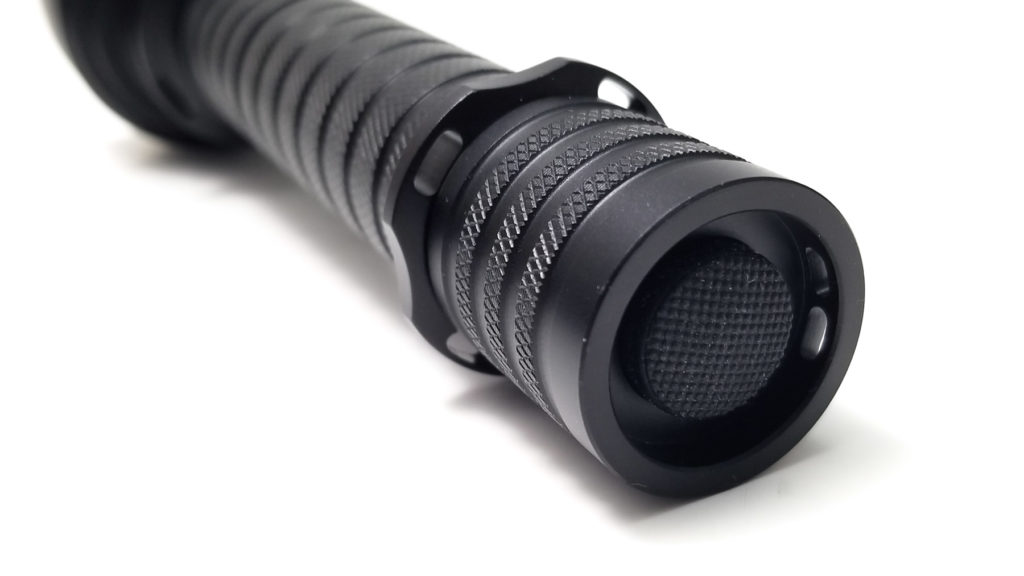
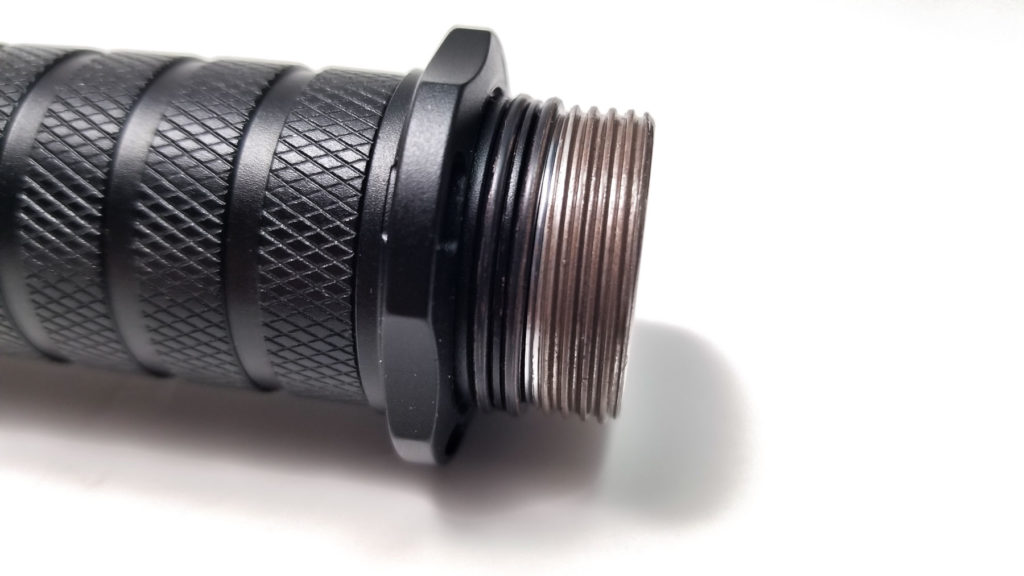
LED, Lens, Bezel, Beam, and Reflector
The NS59v1 features 9 mysterious SFQ55 LEDs from the equally mysterious Chinese manufacturer who also brought us the SFN55.2, and SFS55 LEDs. I do know they are sold on Taobao, the Chinese-language version of Aliexpress (Nightwatch lights are also sold there). Since datasheets for these are either Chinese-only or confidential, for more information, check out this resource from Dave: Emitter Specifications. They’re powerful and pretty cheap, but are inefficient, power-gobbling buggers.
The SFQ55 is a 5mm x 5mm LEDs, the same as the XHP50, SST40 and SFT40. They run on 3 or 6 volts (depending on the MCPCB), and are a domeless flip chip design, bearing a striking resemblance to the XHP50.3 HI. The LES is 6.5mm2, so a bit bigger than a Luminus SFT70. The LEDs are advertised at 5700K, and the Opple Lightmaster Pro agrees, with them coming in at 5720K and 64.6 Ra on High mode. There wasn’t much tint drift (shifting from warmer to cooler) when changing modes either unlike some Luminus and Cree LEDs I’ve tested. Duv was 0.0075, so a bit above BBL, but not bad at all.
The 9* SFQ55 LEDs are positioned behind an OP reflector with a shallow cup for each LED in a radial configuration. There’s a single LED in the center and 8 LEDs on the periphery. The beam is extremely floody, but also has a fair bit of reach to it, throwing tons of light with a huge hotspot surrounded by copious amounts of very bright diffuse spill. The beam is nicely distributed with surprisingly few artifacts and the color is also good with only a bit of green tint at low current, transitioning to nearly pure white at full power.
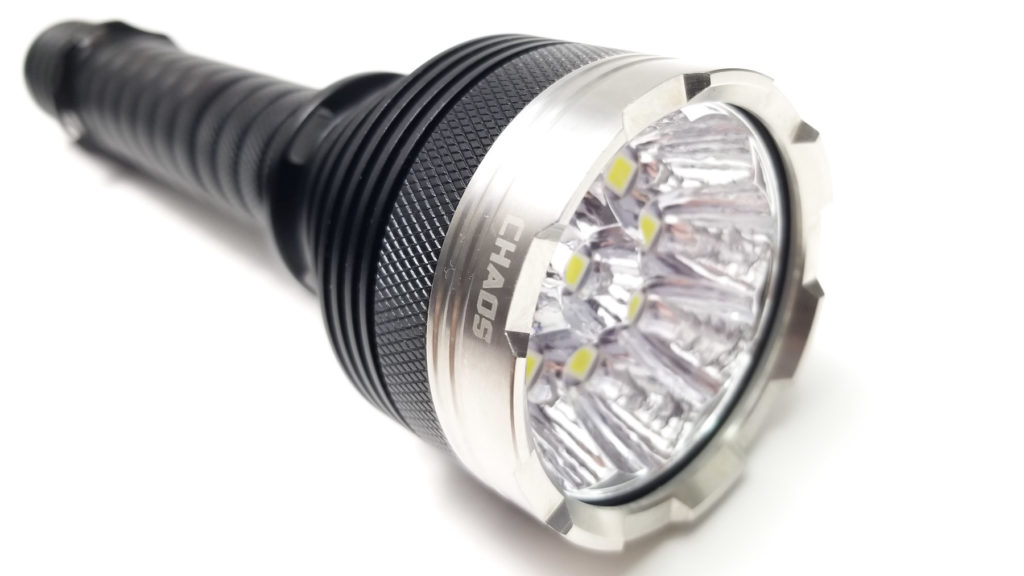
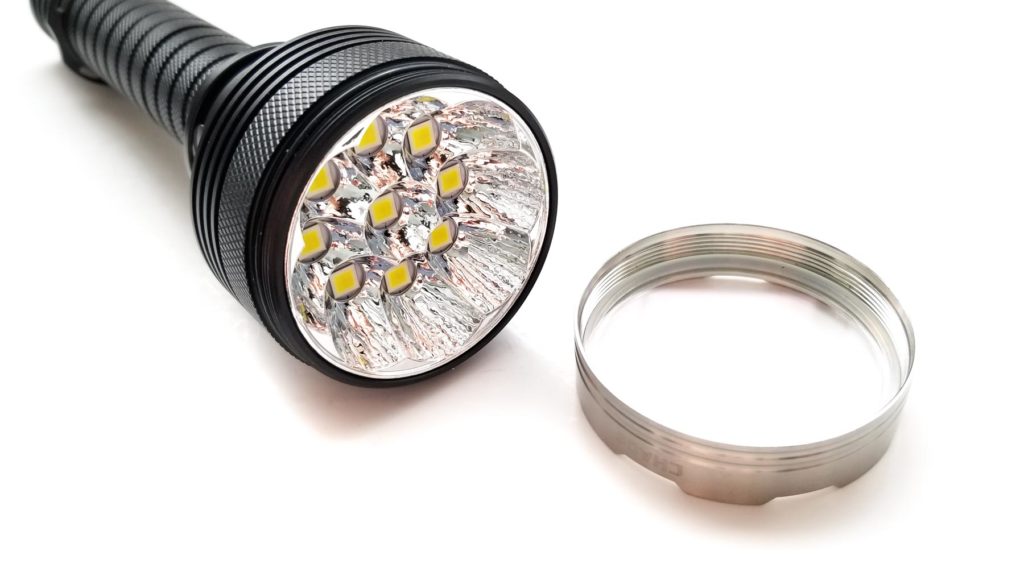
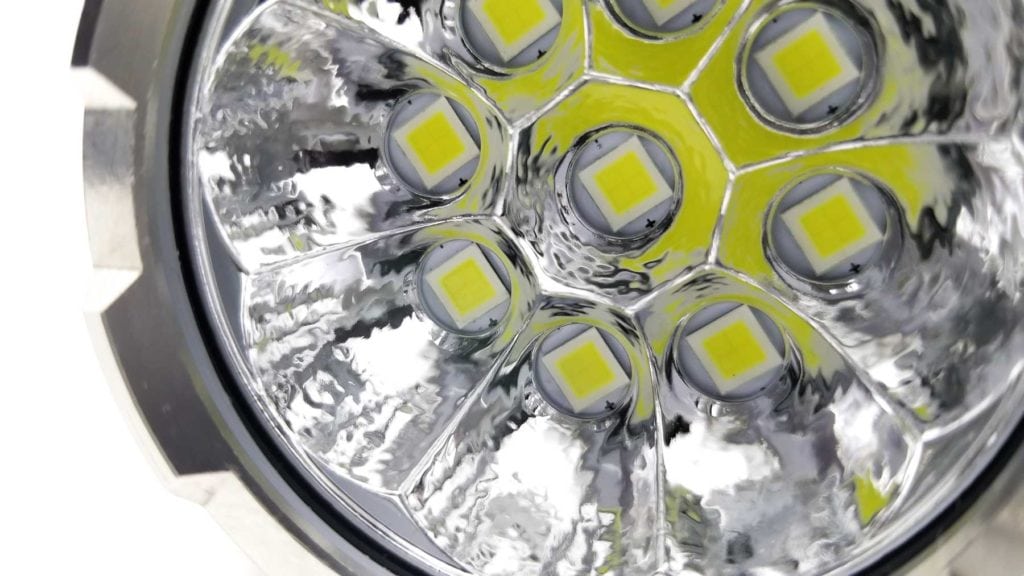

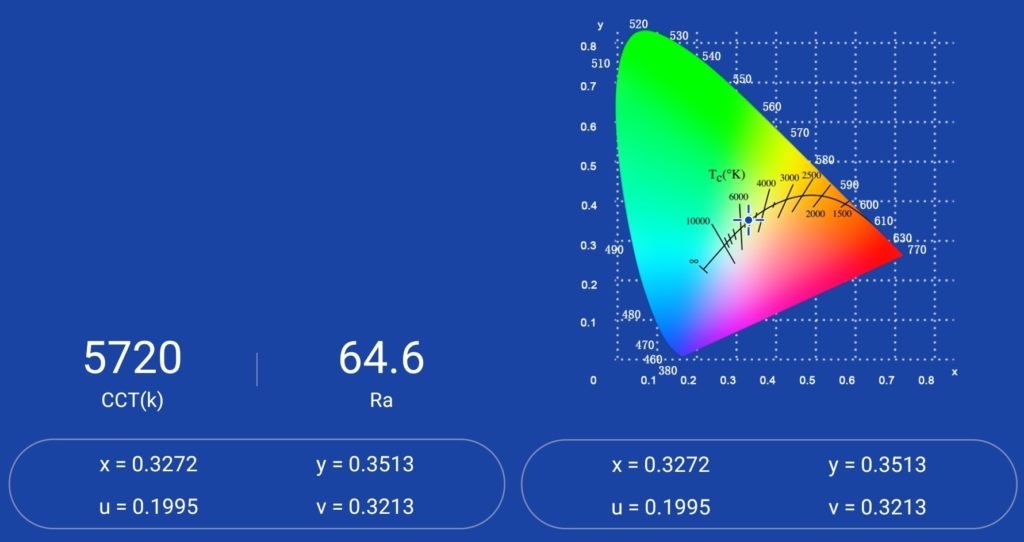
Dimensions and size comparison
Length:
- Length: 21.5 cm / 8.46 inches
- Head diameter: 5.8 cm / 2.28 inches
- Body diameter: 2.68 cm / 1.05 inches
Weight:
- With included 3000 mAh batteries: 489.6 grams / 17.27 oz
- Without batteries: 351.9 grams / 12.41 oz
Flashlight size comparison with its competition
Group 1 left to right: Thorfire C8, Nightwatch NS59v1
Group 2 Back row: Fireflies E07, Nightwatch NI03, Wurkkos DL70, Nightwatch NS59v1, Thrunite TN50, Astrolux FT02s. Front row: Astrolux EC03, Imalent R30C.
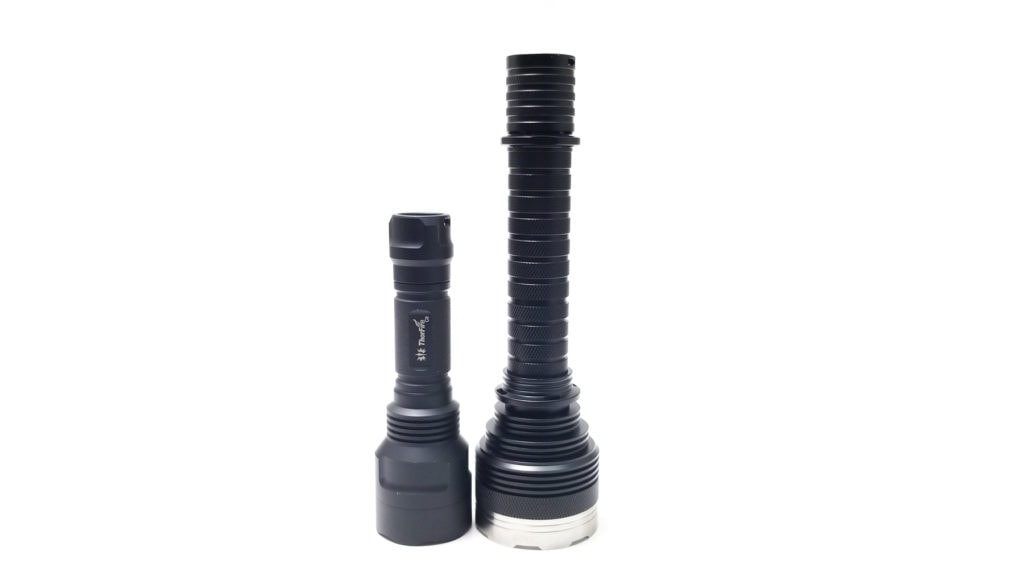
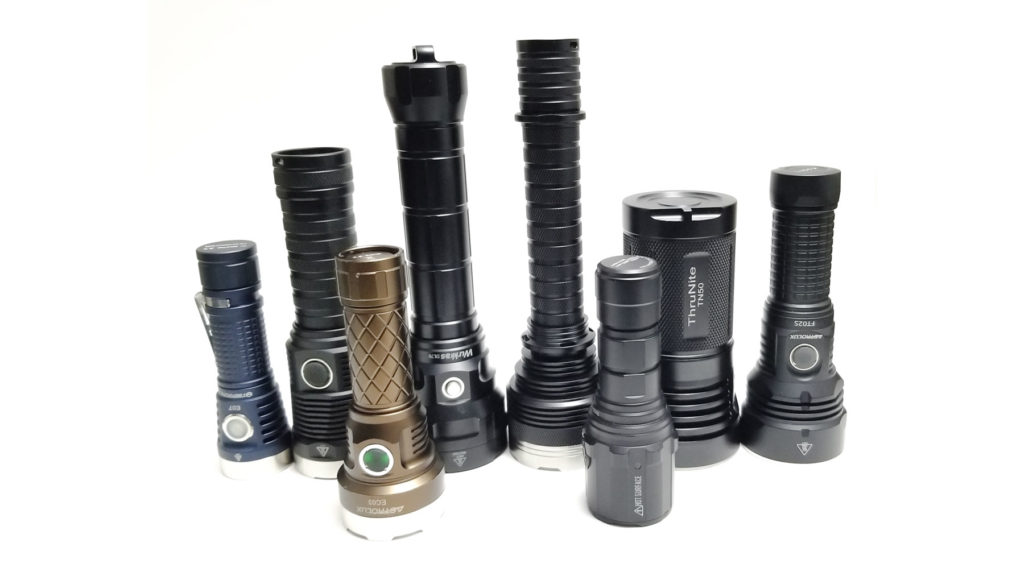
Driver & User Interface:
Since this light runs two cells in series, and the LEDs are 6 volt, there has to be a buck driver in there. I can’t get it out to verify, but that would be sweet if true, and means there’s probably a FET channel along with the regulated channel, but it will be interesting to see which modes are regulated and which run on the FET. Full regulation in lower modes is plausible, but you never know. The runtime test will reveal all.
No Anduril here, folks, but I’m glad the UI is very simple and typical of what I’m used to with clicky switch lights of this type. One click on, one click off with a half press to change modes. There’s Moon, Low, Medium, High, and a double half-press for Turbo and triple half-press for Strobe. Since it’s a reverse clicky, the switch must be fully depressed and released for the light to turn on, so no momentary modes here.
Available modes: Moon, Low, Medium, High Turbo
From OFF:
- Single click: Turns on
From ON:
- Single click: Turns off
- Half press: Changes modes M-L-M-H
- Double half-press: Turbo
- Triple half-press: Strobe
Mode memory
- Yes, but only if the selected mode has been active for more than a few seconds.
Shortcuts:
- Double click for Turbo
- Triple click for Strobe
Low voltage warning:
- Yes. I noticed the light would blink a few times when LVP hits after the output drops very low. But don’t leave the batteries in the light, see the Performance section.
Strobe/blinkies
- Strobe
Lock-out mode:
- None. There’s no manual lockout either.
PWM
- Yes, but fast PWM and not visible with the naked eye.
Additional info on the UI:
- Nightwatch UIs are always simple affairs, and I really like that. There is temperature management onboard that incrementally steps down the brightness on Turbo and High (although High has a timed step down as well), and there is LVP that (somewhat) cuts the power at about 6 volts under load (I had an issue with that).
- There’s one issue here though, and that’s the lack of lockout. Although the switch is recessed in the tailcap, the relatively light switch effort means it can still be pressed on if it bumps against something. If this came on in a bag even on High mode, it could melt and set stuff on fire.
Batteries & Charging
The NS59v1 takes two 21700 batteries arranged in series in the long battery tube for 8.4 volts with fully charged batteries. Due to the series arrangement, you must use a set of matched high drain button top cells. although lower drain cells will work, you will get the most out of the light with cells that can provide over 30 amps or 20C of continuous current, which means you’re limited to Samsung 30T, Samsung 40T, or Molicel P42As. You can use lower drain cells, but at significantly reduced output. Flat top cells do not work. They’re too short and the rear cell doesn’t make contact with the negative of the driver-side cell. You could improvise and solder a 2 mm thick copper button to the flat top positive contact and it would work fine. Cells with protection boards or built-in charging are not going to work here either: too long, and they’d be tripped the moment you click into anything over Medium mode.
Batteries are not included, but can be added when ordering the light. The sample came with those batteries, a couple of 21700s marked as +21700HP 3000 mAh 20C. They had brass buttons soldered to the positive contact and near as I can tell, these look to be made by Hilong Battery, a well-known Chinese battery manufacturer. They’re rated at 3000 mAh and seem to be pretty high discharge. I ran them in my Vapcell S4+ and it shows around 9 milliohms on the internal resistance, which is about the same as a Samsung 30T. No onboard charging means you’ll need a li-ion charger for charging the batteries.

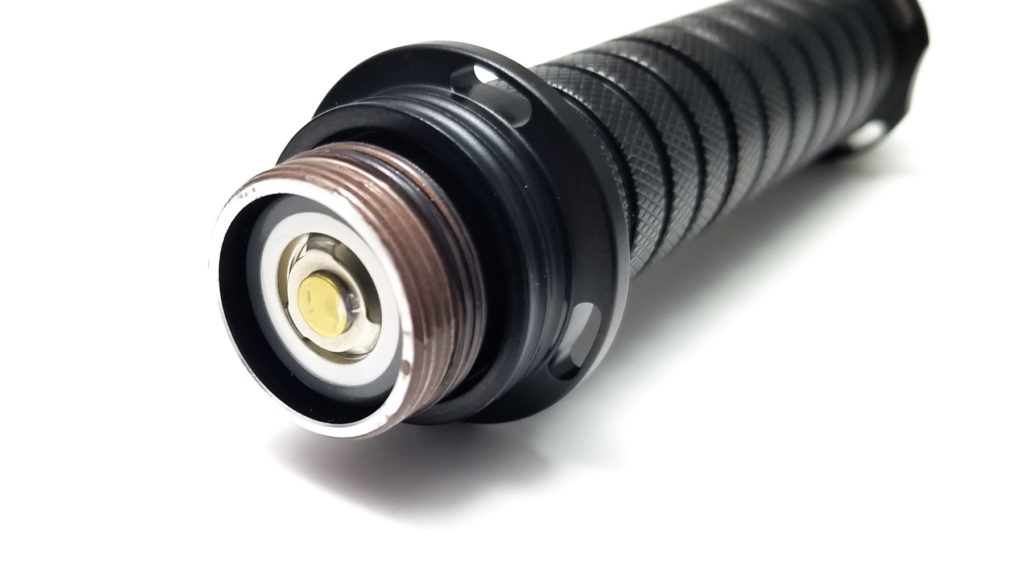
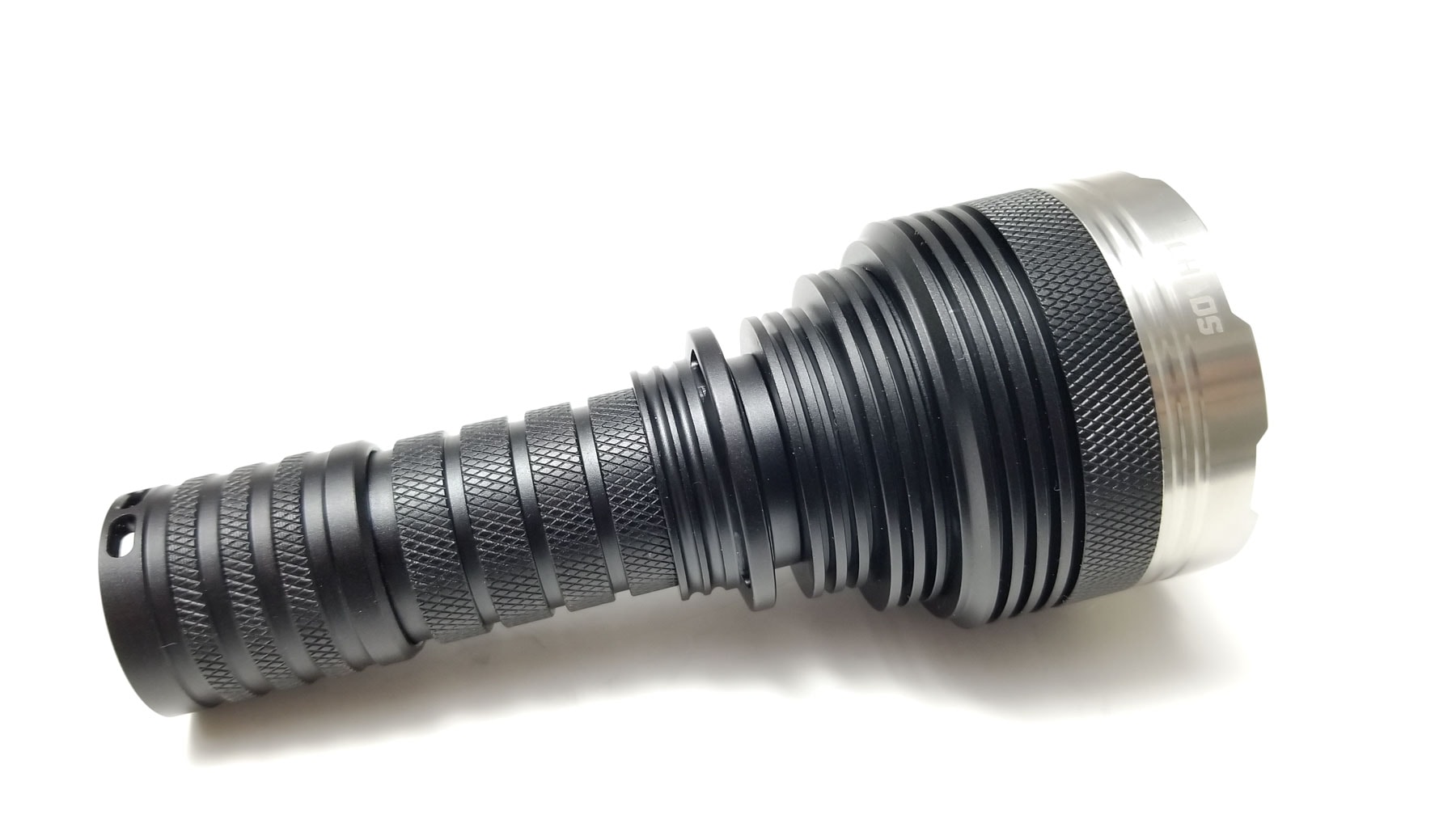
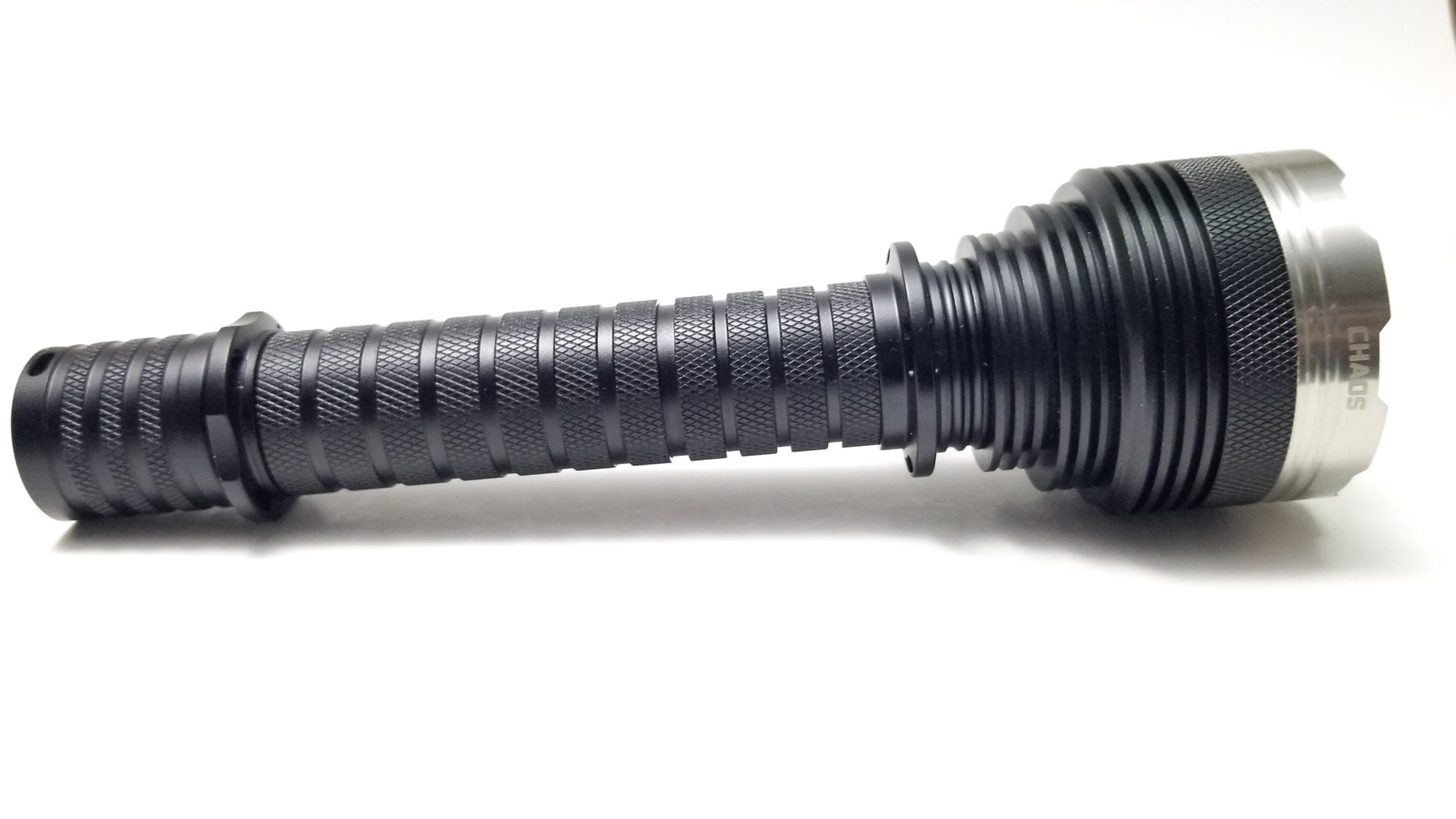
Performance test
Lumen measurements (for each mode)
Lumens are measured using my home made integrating tube, and I use a Digi-Sense 20250-00 datalogging luxmeter. The tube has been calibrated using many lights of known output, including a Maukka calibrated Convoy S2+. These are within 10% of actual. Current was measured with my clamp meter with a loop of 12 gauge wire. All measurements taken at 30 seconds with the fully charged 3000 mAh batteries.
| Mode | Amps at start | Specs | turn on | 30 sec | 10 minutes |
|---|---|---|---|---|---|
| Moon | 650 mA | ? | 688 lm | 688 lm | – |
| Low | 2.26 A | ? | 2299 lm | 2332 lm | 2274 lm |
| Med | 4.87 A | ? | 5198 lm | 5170 lm | 2448 lm |
| High | 24 A | ? | 15,675 lm | 15,675 lm | 50 lm |
| Turbo | 52 A | 28,000 | 27,500 lm | 17,050 lm | 2200 lm |
The mode spacing here is laughable (yep, chaotic, even) with Moon coming in at well over 600 Lumens, and High to Turbo is very…dramatic.
Parasitic drain:
- 6.7 µA
Runtime graph
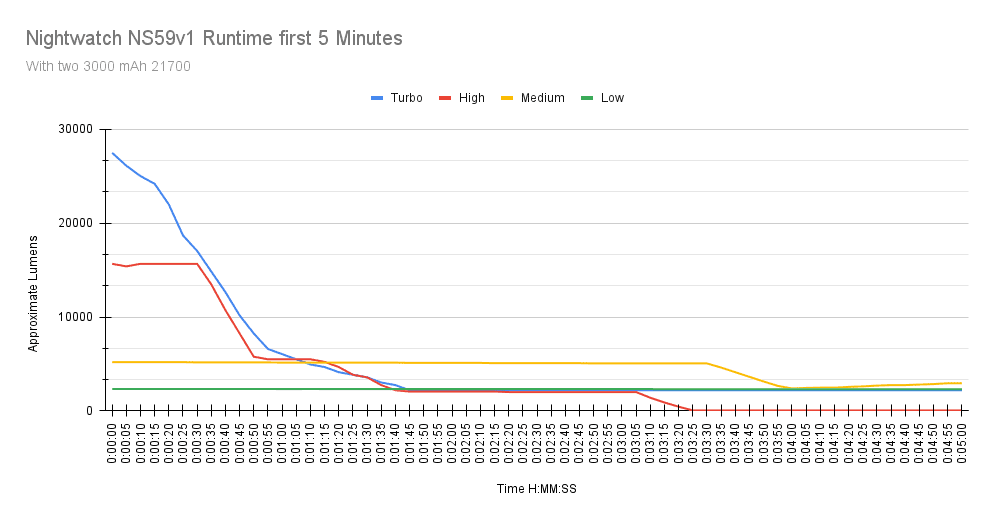
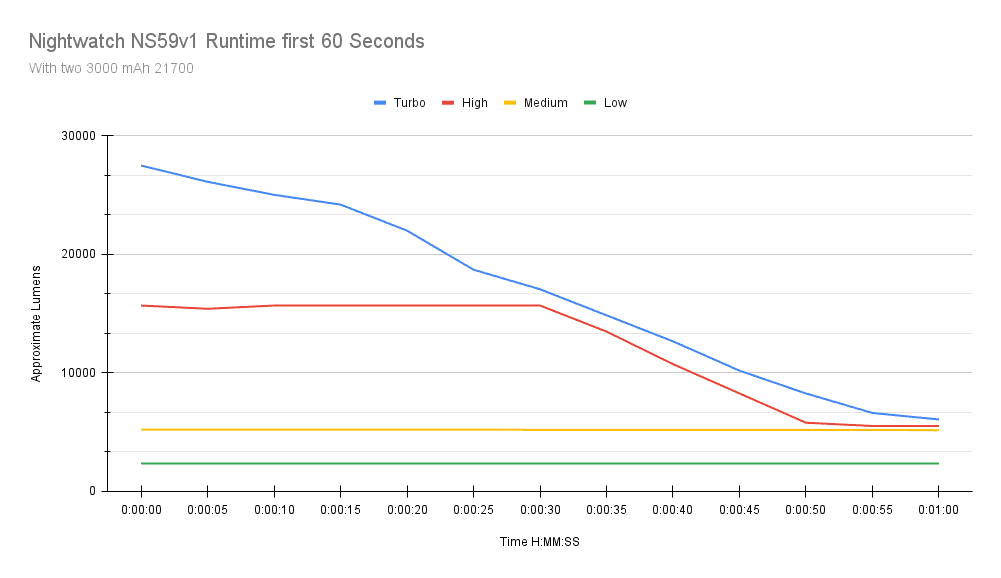
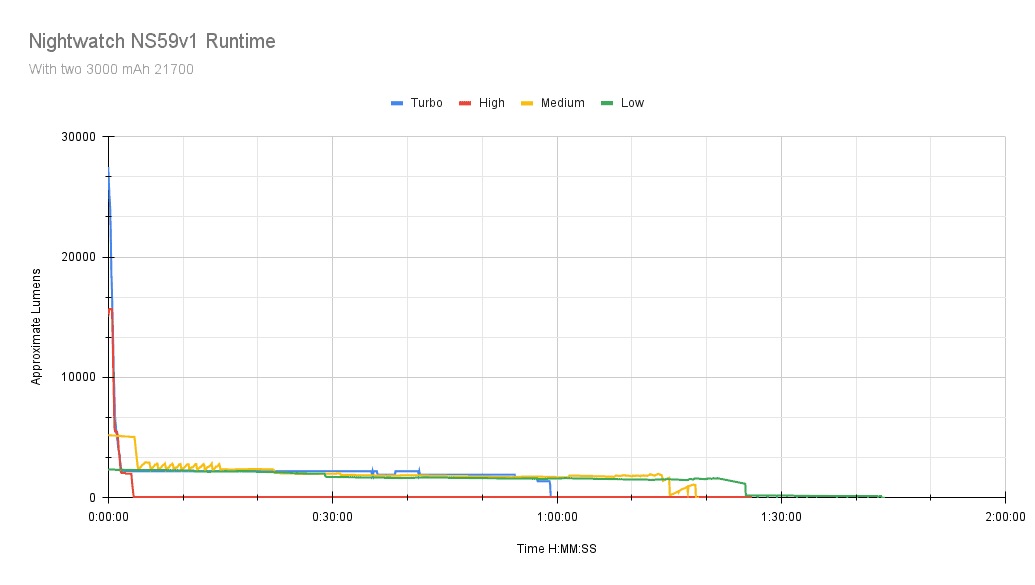
I tested the runtimes in the integrating tube (Low was tested in the sphere) using the Digi-Sense 20250-00 datalogging luxmeter. I tested Low, Medium, High, and Turbo modes utilizing the fully charged included 3000 mAh batteries. Measuring the runtime of the Chaos was a bit chaotic.
Turbo started at 27,500 Lumens. It seemed like too much, so I measured it in the sphere, and it was off by 56 Lumens. The output started dropping within 15 seconds. It’s still over 8000 Lumens by 50 seconds in. By 1 minute 45 seconds, it stabilizes at 2200 Lumens, and holds about 2000 Lumens for 55 minutes, and shuts off 4 minutes later. The light was usable after the Turbo run on Moon-Medium modes for a bit. It got hot fast, from 21 ambient to 33 C by 5 seconds, 10 seconds, 40 C, 30 seconds, 76 C, and hits 77.1 C max, so it’s regulated to about 80 C. The temps stabilized to 65-68 C by 10 minutes. This was a bit too hot for bare hands even on the long tube. The batteries were 3.07 and 2.87 volts after the test.
High starts at 15,675 Lumens, and holds really high output for about 45 seconds, then drops to 2000 Lumens. At 3 minutes, the output takes a nose-dive down to about 50 Lumens. Temps never crested 70 C, which tells me this is a timed step down. It ran at 50 Lumens forever like an Anduril light. I ended the test after 1 hour 26 minutes. High and Turbo could both be reactivated after that, albeit for short periods due to heat.
Medium was somewhat regulated, starting at 5100 Lumens, and held that for better than 3 minutes until a step down to 2300 Lumens by 4 minutes. The brightness was then temperature regulated for about 1 hour 15 minutes until a huge step down to 200 Lumens then more regulation until shut down at 1 hour 18 minutes. It was hand holdable the whole runtime, only hitting 60 C at the head.
Low started at 2300 Lumens, and this was another somewhat regulated mode, holding better than 2000 Lumens for almost 30 minutes, stabilizing with gradual decreases over the next 57 minutes until a deep LVP drop to 190 Lumens at 1 hour 25 minutes and shut down at 1 hour 43 minutes. Low still hit 60 C at 60 minutes in, but heated more slowly than the other modes.
This much output (over 300 watts) generates huge amounts of heat, and it takes a ton of heatsinking to manage it, so quick step downs are expected, but you get tons of light in Turbo, High, and Medium for a good 3 minutes, and more than adequate light for at least an hour and a half in every mode (except High). Unfortunately I experienced an issue, and it’s one echoed by BLF member TacticalGrizzly. After the Medium runtime, I left the light switched on after the shutdown for several hours. When I took the batteries out and charged them, I noticed one was very, very over discharged at only 1.3 volts. The other was pretty deeply discharged as well, down to 2.49 volts. This is obviously bad, and I don’t recommend recharging batteries like that, but I set the Vapcell S4 to Repair mode and got the cell back to life and it seems to be okay (although it knocked several cycles of the lifespan). If I caught the runtime endings, the batteries were sitting between 2.8 and 3.0 volts. I hadn’t noticed it prior, but this light actually damaged itself after the last throw test: One of the LEDs developed a burn mark in the phosphor! It still works fine, but I suspect it will only get worse over time and use.
Throw numbers:
Throw was measured using the Uni-T 383S luxmeter at 5 meters indoors. Readings taken at 30 seconds using the included 3000 mAh batteries.
| Mode | Specs | Candela measured | Meters | Yards |
|---|---|---|---|---|
| Moon | ? | 2975 cd | 109 | 119 |
| Low | ? | 9550 cd | 195 | 214 |
| Medium | ? | 19950 cd | 282 | 309 |
| High | ? | 34,875 cd (71,925 at start) | 373 (536) | 409 (587) |
| Turbo | ? | 58,400 cd (119,050 cd at start) | 483 (690) | 529 (755) |
No throw figures on Nealsgadgets for this light, but 690 meters of throw at turn on isn’t bad for a flooder. The Turbo output is stepping down at the 30 second mark, along with High mode. Very decent performance here!
Extra info: Peak beam distance according to ANSI FL1 standards: The calculated value of distance in meters at which the flashlight produce a light intensity of 0.25 lux. (0.25 lux is about the brightness of a full moon shining on an object).
Beamshots
I ran the Chaos alongside some other bright lights: The Thrunite TN50 (measured 18,000+), Nightwatch NI03 Valkyrie (Measured 7700 Lumens 1x SFN55.2), Astrolux MF01 Mini (7300 Lumens measured), Sofirn SP36 Pro (5500 Lumens 4x SST40), Astrolux EC03 (5200 Lumens, 3x SST40), Customized SRK (6000 Lumens measured 4x SST40), and Imalent R30C (8100 Lumens).
I also tested it against the Wuben A1 and Fenix LR80, two other lights capable of high output.
The fence is about 40 m away. You can see the differences in beam profiles and throw distance pretty well. The NS59v1 has pretty good throw for a flooder light!
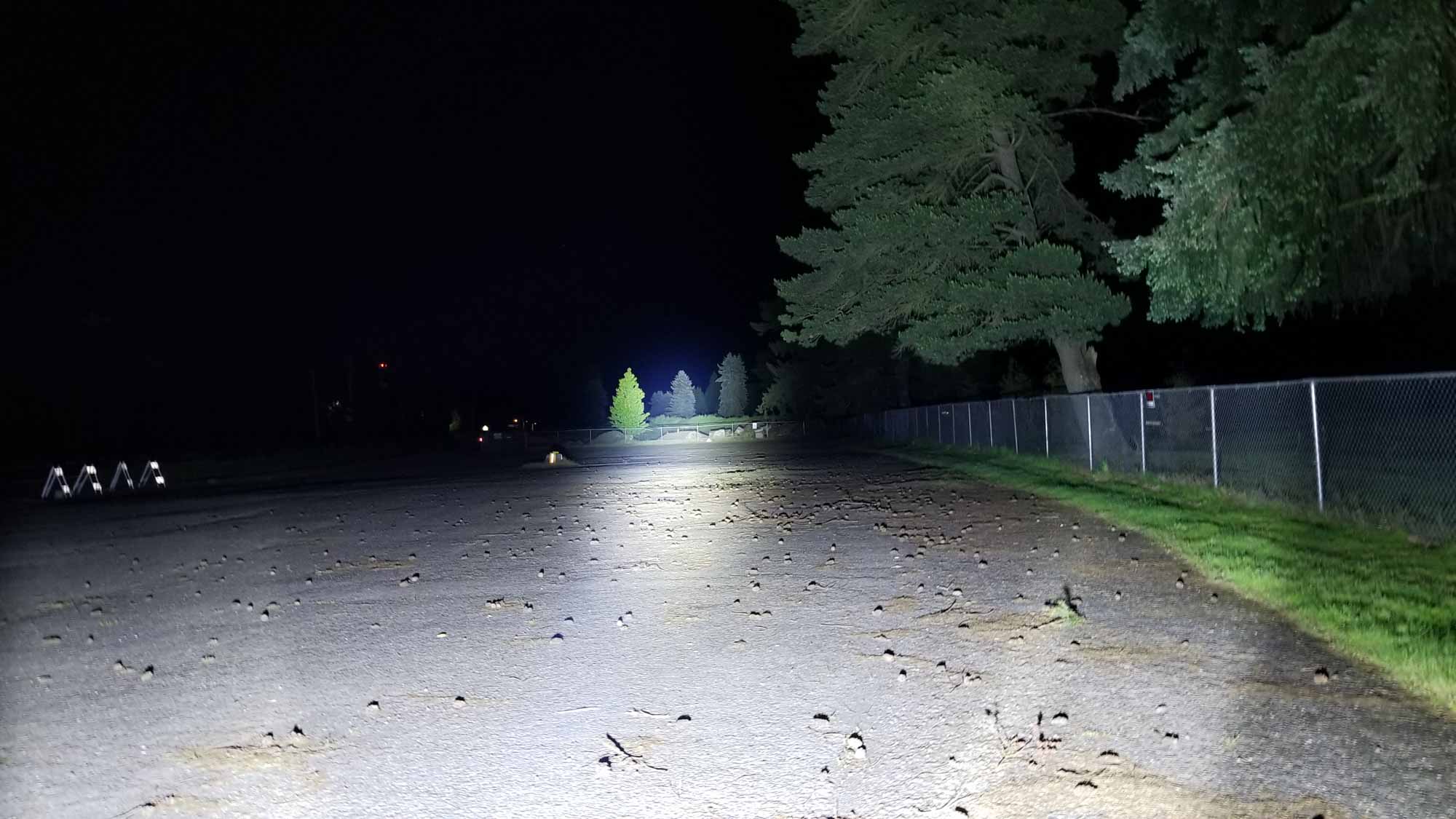
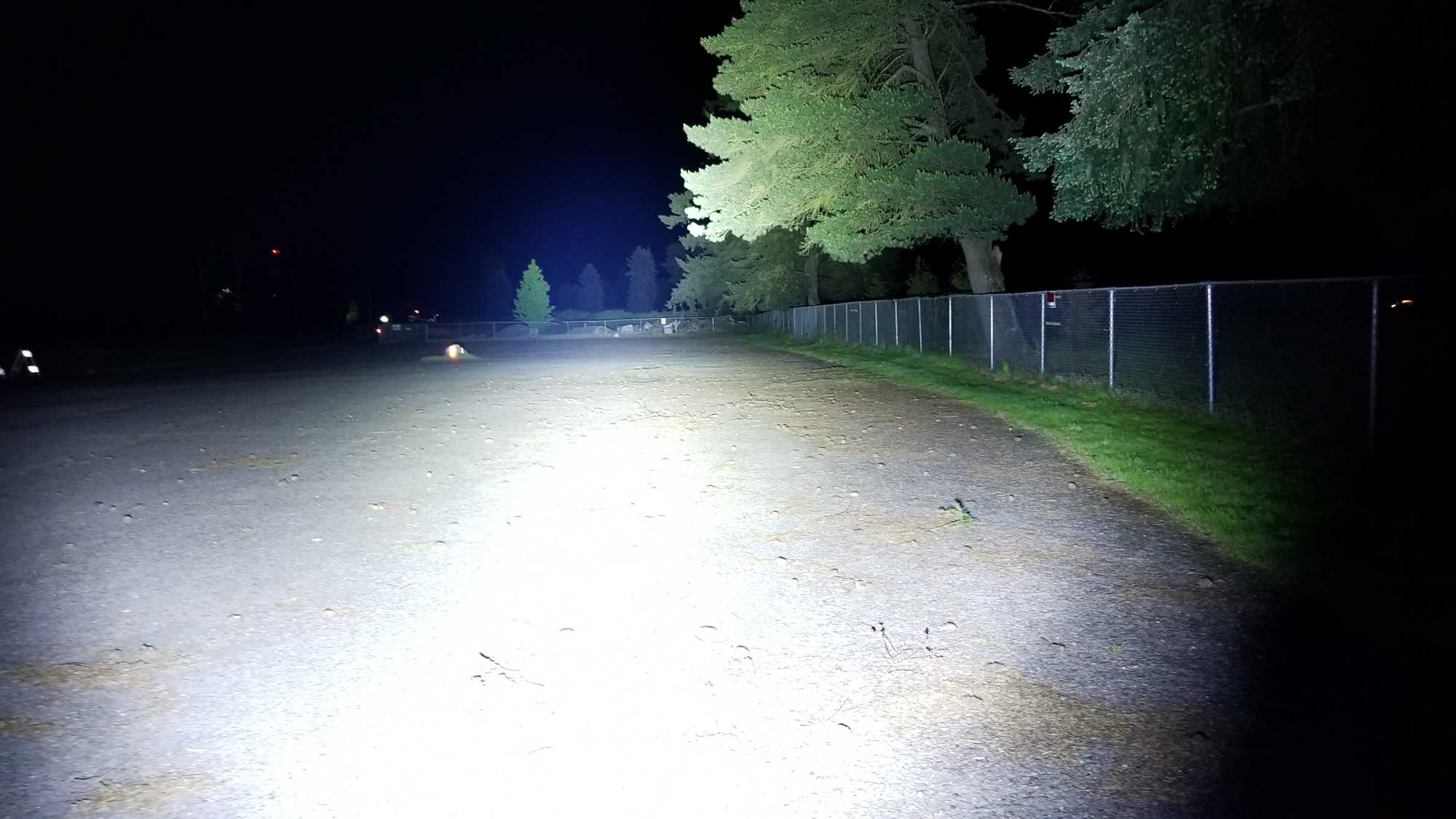
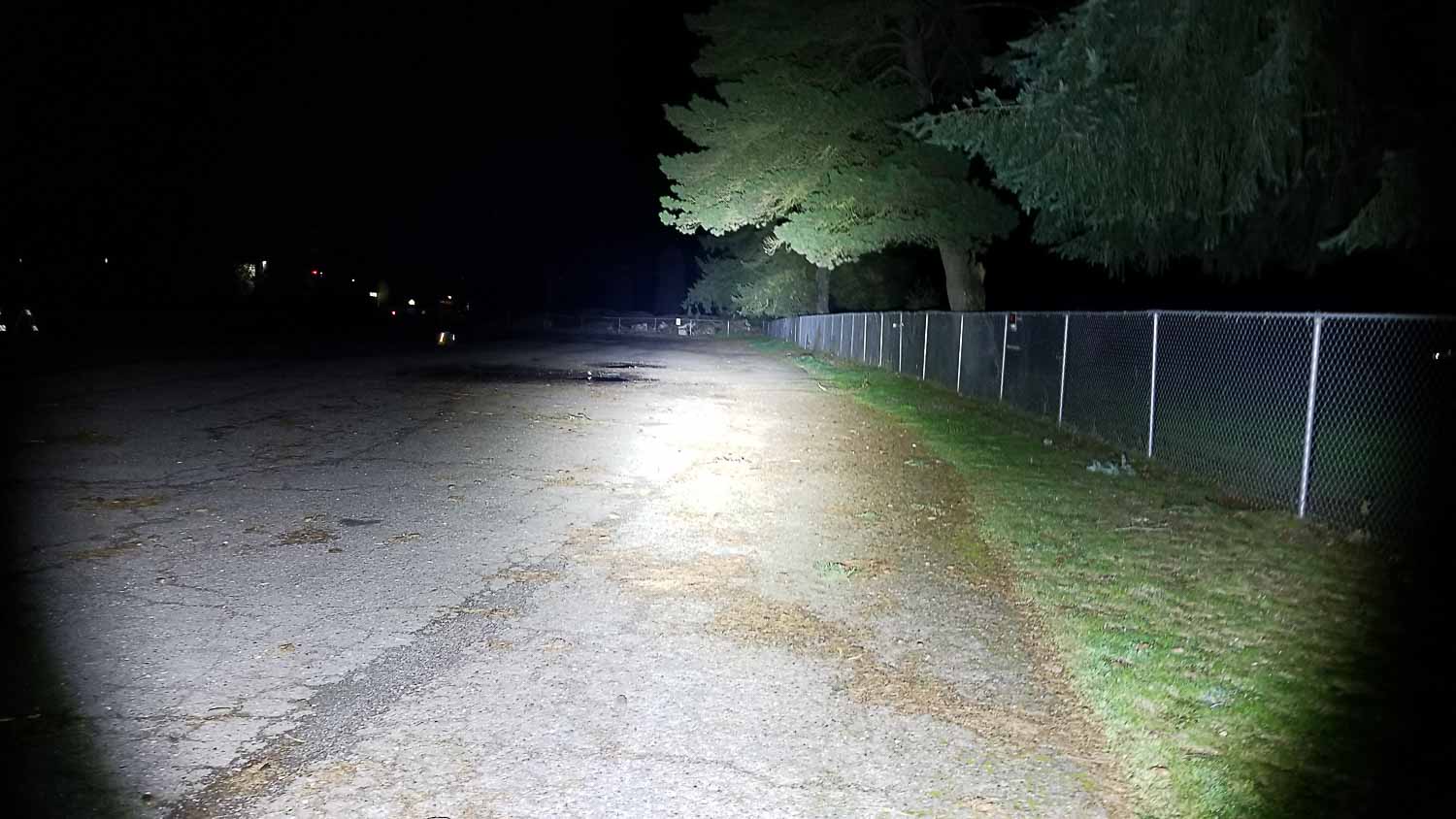










Disclaimer: This flashlight was sent to me for review at no cost by Nealsgadgets. I have not been paid to review, nor have I been holding back on problems or defects.
Final Verdict
Pros
- Awesome Lumen per dollar value
- Crazy high output
- Somewhat regulated driver
- Decent build quality
- Nicely balanced floody beam
- Simple UI
Cons
- LVP kind of works
- No lockout whatsoever
- Mode spacing is terrible
- Touchy switch
- Damages itself
Explanation on star ratings:
1: Avoid: my phone flashlight would be a better choice – 2: Poor: significant defect or issues; almost unusable – 3: Average: some defects or issues; but still usable 4: Good: recommended (minor issues) – 5: Great: highly recommended

3 stars: ★★★
These are affordable, well-built, functional lights with simple UIs, and the NS59v1 is no exception, and it definitely lived up to its alias, Chaos. Nearly 28,000 Lumens in a sub-500 gram light is insane. It behaves accordingly, and from an output/price perspective, no other light can touch the NS59v1. Period. We’re talking about 28,000 Lumens for about $100.
To get that performance, you’re buying something from Imalent, Thrunite, or Acebeam that costs a lot more. On lower modes, this is a pretty versatile light. It’s more portable than a soda or soup can light, and lighter too. Even Moon mode is bright enough for a lot of tasks, and Medium is somewhat regulated and pretty useful, with 5000 Lumens available for a decent time, with absolutely, positively blinding Turbo for about 30 seconds.
The UI is simple. The beam is decent, and you get quite a bit of throw for a flooder. The mode spacing is bad, and it’s missing lockout, which is an important safety feature. This light is so powerful, it even damaged itself, with one of the LEDs developing a visible burn mark on the LES. The worst part? The LVP. LVP is supposed to cut off the current flow to the driver to save your batteries from being over discharged, and it mostly works here, but if you keep the switch closed, even after shut down, the parasitic drain can seriously overdischarge your batteries and ruin them.
This is a bit unacceptable, but to be fair, the light does give you warning that it’s time to turn off and recharge. Do I recommend the NS59v1? Yes, but with caution that it’s not for novices. It’s a neat light with some usefulness, but practical? Not really (a bit like a Ferrari as a daily driver)
Nightwatch NS59v1 discount coupon code
1Lumen discount code: 1lumen711
Time limit discount code: 1lumenNew (higher discount, limited time)
1lumen selects and reviews products personally. We may earn affiliate commissions through our links, which help support our testing.